外研版(2019)选择性必修 第二册Unit 3 Times change! Developing ideas 课件(共14张PPT)
文档属性
| 名称 | 外研版(2019)选择性必修 第二册Unit 3 Times change! Developing ideas 课件(共14张PPT) | 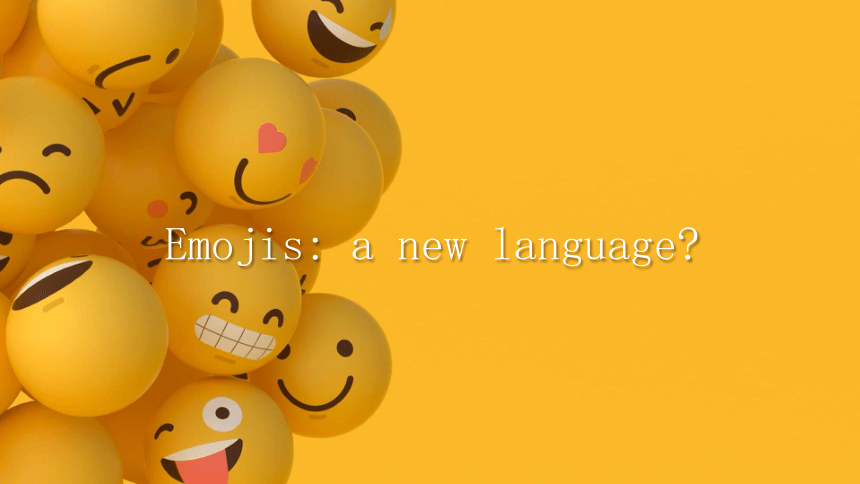 | |
| 格式 | pptx | ||
| 文件大小 | 17.2MB | ||
| 资源类型 | 教案 | ||
| 版本资源 | 外研版(2019) | ||
| 科目 | 英语 | ||
| 更新时间 | 2023-02-03 21:55:12 | ||
图片预览

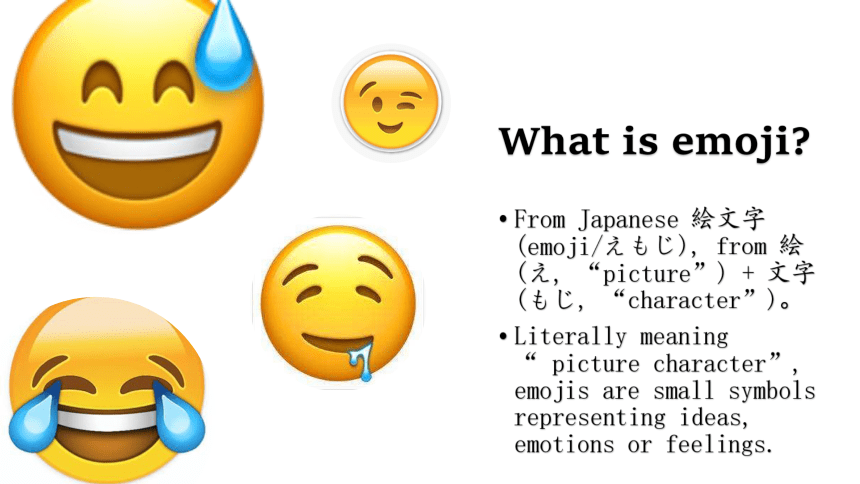

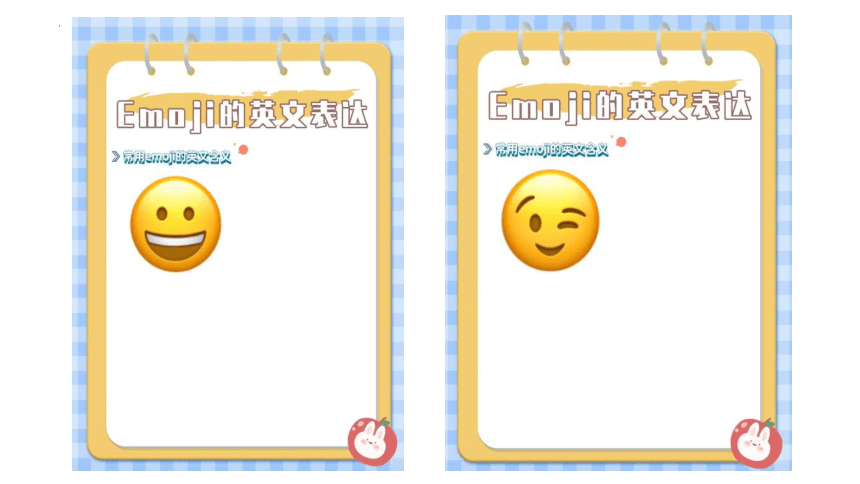
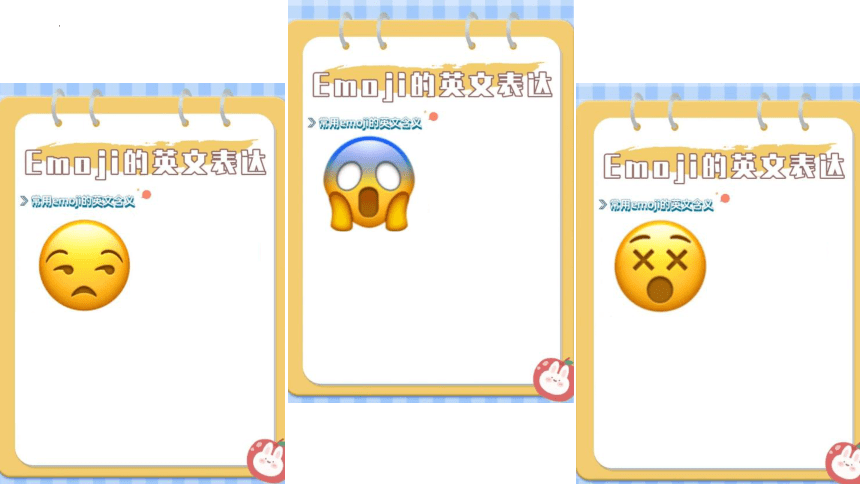
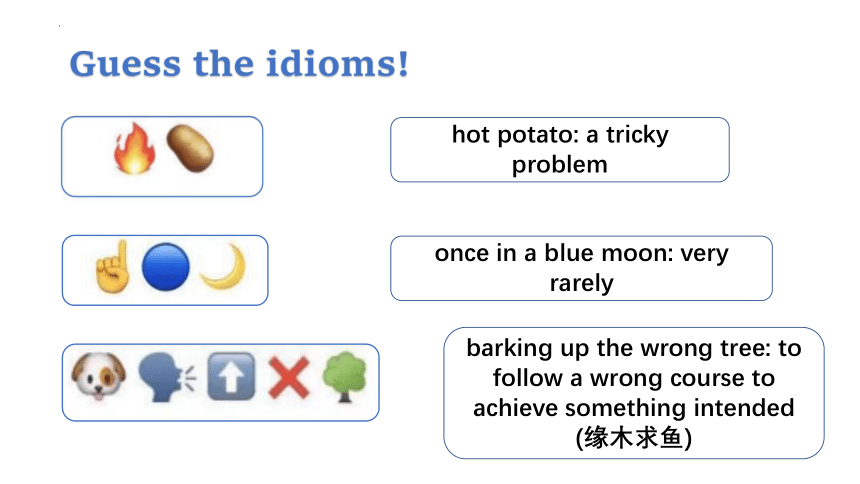
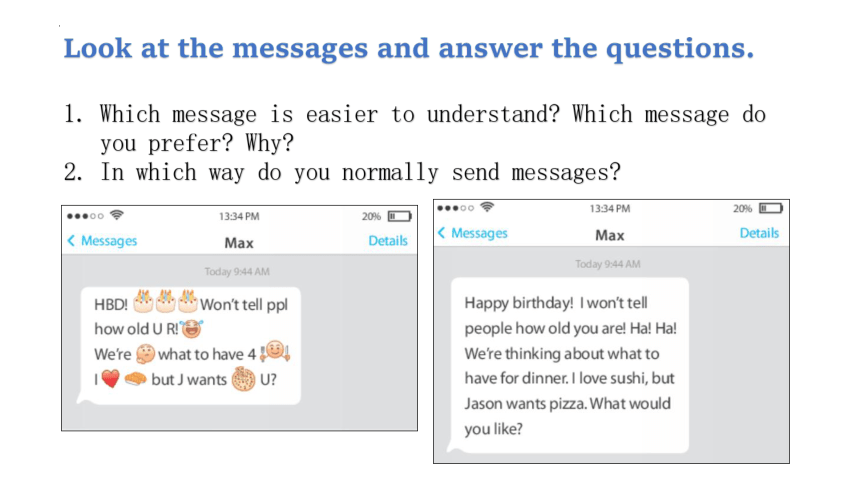
文档简介
(共14张PPT)
Emojis: a new language
What is emoji
From Japanese 絵文字 (emoji/えもじ), from 絵 (え, “picture”) + 文字 (もじ, “character”)。
Literally meaning “ picture character”, emojis are small symbols representing ideas, emotions or feelings.
Guess the idioms!
hot potato: a tricky problem
barking up the wrong tree: to follow a wrong course to achieve something intended (缘木求鱼)
once in a blue moon: very rarely
Look at the messages and answer the questions.
Which message is easier to understand Which message do you prefer Why
In which way do you normally send messages
Look at the title of the passage and predict the author’s attitude towards emojis.
The author may be skeptical/doubtful about emojis as a new language.
Skim the passage and match the main idea of each part.
Examples of using emojis.
The popularity and development of emojis.
The application of emojis.
Emojis’ future development and the author’s concern.
Para 1~__
Para __~__
Para __~__
Para 8
2
5
3
7
6
Reading
Read paragraph 1 and 2. What are the meanings of the two sets of emojis
“I’d be running late and would be there soon.”
“OK! Don’t rush.”
Read para 3-5
How popular emojis are now
A. Using emojis to communicate isn’t common
B. They are an essential part of today’s language
C. They are an impolite way to express ourselves
D. Their development is slow
Why do the writer mention the Oxford Dictionaries Word of the year here
A. To show the popularity of emojis
B. To introduce the authority (权威) of the Oxford Dictionaries
C. To tell the government’ support for emojis
D. To stress the importance of emojis
Para. 3: With the rapid development of social media, emojis are becoming an integral component of the language we use to express ourselves.
Para. 5: Due to their popularity, the Oxford Dictionaries Word of the Year in 2015 was for the first time ever, a pictograph instead of a traditional word.
Read para 6-7
What is the advantage of using emojis in daily life and classical literature
add emotional meaning
quick and easy to use
help express feelings when there is no appropriate words
make the classics more accessible to young readers
Read para 8
Why educators are worried about the use of emojis
Because we may not be able to communicate by language one day
Because people prefer emojis to written and spoken words
Because people probably will completely rely on the pictorial language to communicate
Group discussion
“Perhaps people will one day choose to communicate in pictures, and forget how to write properly.” (P44)
Do you agree or disagree with the sentence Discuss with your group mates and sort your ideas.
Provide three reasons to support your ideas and present your ideas to the whole class.
Emojis: a new language
What is emoji
From Japanese 絵文字 (emoji/えもじ), from 絵 (え, “picture”) + 文字 (もじ, “character”)。
Literally meaning “ picture character”, emojis are small symbols representing ideas, emotions or feelings.
Guess the idioms!
hot potato: a tricky problem
barking up the wrong tree: to follow a wrong course to achieve something intended (缘木求鱼)
once in a blue moon: very rarely
Look at the messages and answer the questions.
Which message is easier to understand Which message do you prefer Why
In which way do you normally send messages
Look at the title of the passage and predict the author’s attitude towards emojis.
The author may be skeptical/doubtful about emojis as a new language.
Skim the passage and match the main idea of each part.
Examples of using emojis.
The popularity and development of emojis.
The application of emojis.
Emojis’ future development and the author’s concern.
Para 1~__
Para __~__
Para __~__
Para 8
2
5
3
7
6
Reading
Read paragraph 1 and 2. What are the meanings of the two sets of emojis
“I’d be running late and would be there soon.”
“OK! Don’t rush.”
Read para 3-5
How popular emojis are now
A. Using emojis to communicate isn’t common
B. They are an essential part of today’s language
C. They are an impolite way to express ourselves
D. Their development is slow
Why do the writer mention the Oxford Dictionaries Word of the year here
A. To show the popularity of emojis
B. To introduce the authority (权威) of the Oxford Dictionaries
C. To tell the government’ support for emojis
D. To stress the importance of emojis
Para. 3: With the rapid development of social media, emojis are becoming an integral component of the language we use to express ourselves.
Para. 5: Due to their popularity, the Oxford Dictionaries Word of the Year in 2015 was for the first time ever, a pictograph instead of a traditional word.
Read para 6-7
What is the advantage of using emojis in daily life and classical literature
add emotional meaning
quick and easy to use
help express feelings when there is no appropriate words
make the classics more accessible to young readers
Read para 8
Why educators are worried about the use of emojis
Because we may not be able to communicate by language one day
Because people prefer emojis to written and spoken words
Because people probably will completely rely on the pictorial language to communicate
Group discussion
“Perhaps people will one day choose to communicate in pictures, and forget how to write properly.” (P44)
Do you agree or disagree with the sentence Discuss with your group mates and sort your ideas.
Provide three reasons to support your ideas and present your ideas to the whole class.
